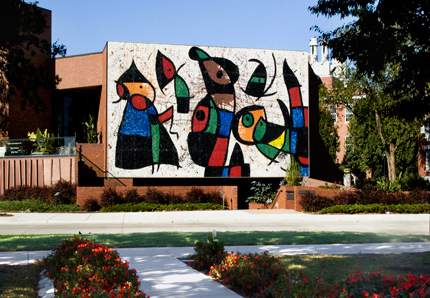The Ulrich Museum of Art at Wichita State University has been awarded two major federal grants totaling $250,000 from the National Endowment for the Arts (NEA) and the Institute of Museum and Library Services (IMLS) for the conservation of the landmark mural and masterpiece by modern artist Joan Miro.
The announcement of the Ulrich Museum as a grant recipient from both organizations in 2012 is significant because the Ulrich is the only Kansas museum to receive both the NEA and IMLS grants in 2012 and is the only Kansas museum to receive the maximum grant amounts from the NEA ($100,000) and IMLS ($150,000).
The funds from the grants, written and submitted by Ulrich Museum Director Patricia McDonnell, will support the second year of the five-year undertaking to conserve “Personnages Oiseaux” (“Bird People”), the 26 x 52 foot glass-and-marble mosaic. The mosaic was created specifically for the Ulrich Museum and installed on its facade in 1978.
The mosaic was deinstalled in fall 2011 in preparation for treatment; 33 years of exposure to extreme weather in Kansas has taken its toll on the 80-panel mosaic.
Key surrealist
A native of Barcelona but mainly based in Paris, Joan Miro (1893-1983) was a key surrealist in the period between the world wars. So esteemed is his artistic excellence, in 2009-2011, the Museum of Modern Art and the Metropolitan Museum of Art in New York and the Tate Galley in London organized exhibitions devoted to this key figure in the School of Paris along with Pablo Picasso and Marc Chagall.
Of 11 monumental murals Miro created worldwide in the 43-year-period between 1937 and 1980, the Ulrich Museum’s mosaic is the largest of only four in the United States and one of only two murals outside New York City. It is the only predominately glass mosaic he ever created.
Russell-Marti Conservation Services Inc., based in California, Mo., has been contracted by the Ulrich Museum to lead the Miro conservation effort, which is expected to take until fall 2016.
For more information about the Miro Conservation Project, visit www.beamirohero.com.


 File
File